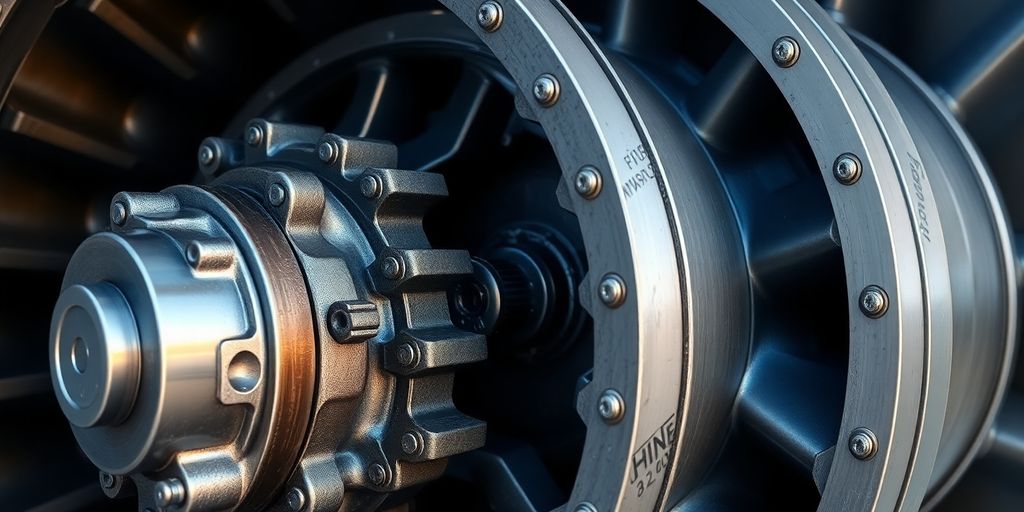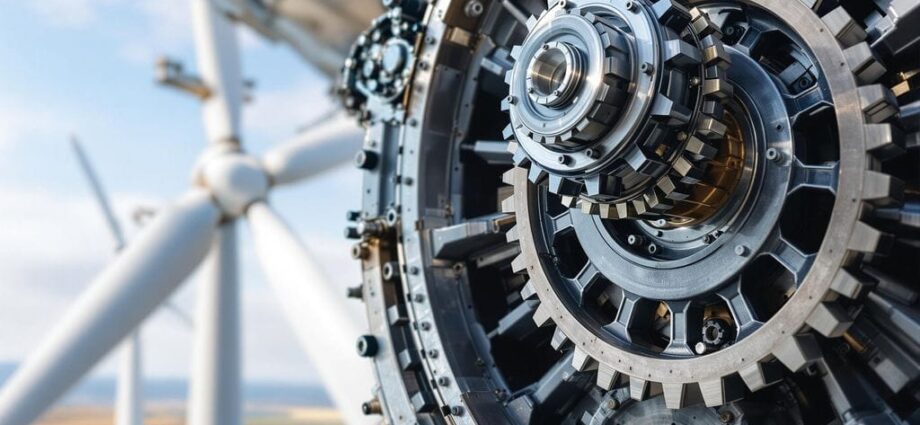Wind turbine gearboxes play a crucial role in the operation of wind turbines. They help convert the slow rotation of turbine blades into faster speeds that can generate electricity. Understanding how these gearboxes work, their types, and their maintenance is essential for anyone interested in renewable energy. This guide will explore the key aspects of wind turbine gearboxes, from their design to their impact on performance.
Key Takeaways
- Wind turbine gearboxes are essential for converting blade movement into electrical energy.
- There are different types of gearboxes, including planetary and parallel shaft designs.
- Proper maintenance is key to preventing gearbox failures and ensuring long-lasting performance.
- New materials and technologies are changing the way gearboxes are designed and built.
- The future of gearbox technology is influenced by renewable energy policies and the need for efficiency.
Understanding Wind Turbine Gearboxes
Wind turbine gearboxes are essential components that help convert the energy from wind into usable electricity. These gearboxes play a crucial role in ensuring that the turbine operates efficiently.
Components of a Wind Turbine Gearbox
A typical wind turbine gearbox consists of several key parts:
- Input Shaft: Connects to the turbine rotor.
- Gear Sets: Change the speed of rotation.
- Output Shaft: Transfers energy to the generator.
Functionality of Gearboxes in Wind Turbines
The main function of a gearbox is to increase the rotational speed from the turbine blades to a level suitable for the generator. This process involves:
- Speed Increase: The gearbox boosts the low-speed rotation from the blades.
- Torque Management: It helps manage the torque to prevent damage.
- Energy Transfer: Efficiently transfers energy to the generator.
Common Materials Used in Gearbox Construction
Gearboxes are made from various materials to ensure durability and performance. Common materials include:
- Steel: Strong and durable, often used for gears.
- Aluminum: Lightweight, used in some components.
- Composite Materials: Used for reducing weight while maintaining strength.
The efficiency of a wind turbine gearbox can significantly impact the overall performance of the turbine.
In summary, understanding the components, functionality, and materials of wind turbine gearboxes is vital for grasping how they contribute to energy production.
Types of Wind Turbine Gearboxes

Wind turbine gearboxes are essential for converting the low-speed rotation of the turbine blades into higher-speed rotation needed for electricity generation. There are several types of gearboxes used in wind turbines, each with its own unique design and application.
Planetary Gearbox Systems
- Compact design: Planetary gearboxes are known for their small size and high power density.
- Load distribution: They distribute loads evenly across multiple gears, which helps in reducing wear and tear.
- High efficiency: These systems often achieve higher efficiency compared to other types.
Parallel Shaft Gearbox Designs
- Simplicity: Parallel shaft gearboxes have a straightforward design, making them easier to manufacture and maintain.
- Versatility: They can be used in various applications beyond wind turbines.
- Cost-effective: Generally, they are less expensive than planetary systems.
Hybrid Gearbox Configurations
- Combination of designs: Hybrid gearboxes combine features from both planetary and parallel shaft designs.
- Enhanced performance: They aim to provide the benefits of both systems, such as efficiency and simplicity.
- Adaptability: These gearboxes can be tailored to meet specific turbine requirements.
In summary, the choice of gearbox type can significantly impact the performance and efficiency of wind turbines. Understanding these types helps in selecting the right system for specific applications.
| Gearbox Type | Advantages | Disadvantages |
|---|---|---|
| Planetary Gearbox | High efficiency, compact design | More complex to manufacture |
| Parallel Shaft Gearbox | Simplicity, cost-effective | Lower efficiency compared to planetary |
| Hybrid Gearbox | Combines benefits of both types | Can be more expensive |
Each type of gearbox plays a crucial role in the overall efficiency and effectiveness of wind turbines. Understanding these differences is key to optimizing performance and ensuring longevity in wind energy systems.
Design and Engineering of Gearboxes
Key Design Considerations
When designing gearboxes for wind turbines, several important factors must be taken into account:
- Load Capacity: Gearboxes must handle the heavy loads from wind forces.
- Efficiency: High efficiency is crucial for maximizing energy output.
- Durability: Gearboxes should withstand harsh weather conditions and long operational hours.
Engineering Challenges and Solutions
Engineers face various challenges in gearbox design, including:
- Vibration Control: Excessive vibrations can lead to failures. Using dampers can help.
- Heat Management: Gearboxes generate heat, which can damage components. Cooling systems are essential.
- Material Selection: Choosing the right materials is vital for strength and weight reduction.
Innovations in Gearbox Technology
Recent advancements in gearbox technology include:
- Smart Sensors: These help in monitoring performance and detecting issues early.
- Advanced Materials: New materials improve strength and reduce weight.
- Modular Designs: These allow for easier repairs and upgrades.
The prevention of wind turbine gearbox failures is the product of a combination of proper maintenance, early detection, and thorough analysis of collected data.
By focusing on these areas, engineers can create more reliable and efficient gearboxes for wind turbines.
Maintenance and Troubleshooting
Routine Maintenance Practices
Regular maintenance is crucial for keeping wind turbine gearboxes in good shape. Here are some key practices:
- Inspect the gearbox regularly for any signs of wear or damage.
- Change the oil at recommended intervals to ensure proper lubrication.
- Check for unusual noises or vibrations that could indicate a problem.
Identifying Gearbox Failures
Recognizing issues early can save time and money. Look for these signs:
- Unusual sounds like grinding or clunking.
- Vibration levels that are higher than normal.
- Oil leaks around the gearbox area.
Repair and Replacement Strategies
When problems arise, it’s important to have a plan. Here are some strategies:
- Assess the damage to determine if repair or replacement is needed.
- Consult with experts for complex issues.
- Follow manufacturer guidelines for repairs to ensure safety and efficiency.
Regular maintenance is essential for the longevity of wind turbine gearboxes. Ignoring small issues can lead to bigger problems down the line.
In summary, keeping an eye on your wind turbine gearbox through routine checks, identifying problems early, and having a solid repair plan can greatly enhance performance and lifespan.
Impact on Wind Turbine Performance

Efficiency Improvements with Advanced Gearboxes
Advanced gearboxes play a crucial role in enhancing the efficiency of wind turbines. By optimizing the gear ratio, these systems can convert wind energy into mechanical energy more effectively. Here are some key benefits of using advanced gearboxes:
- Increased energy conversion rates
- Reduced energy losses
- Improved overall turbine performance
Role in Energy Output Optimization
The design and functionality of gearboxes directly influence the energy output of wind turbines. A well-designed gearbox can:
- Maximize the rotational speed of the generator.
- Minimize wear and tear on components.
- Ensure consistent energy production even in varying wind conditions.
Influence on Turbine Longevity
Properly functioning gearboxes can significantly extend the lifespan of wind turbines. Regular maintenance and timely repairs help prevent major failures. Here are some factors that contribute to turbine longevity:
- Quality of materials used in gearboxes
- Effective cooling systems to manage heat
- Regular inspections and maintenance schedules
The performance of wind turbines is not just about generating energy; it’s also about ensuring that they operate efficiently and last longer.
In summary, the impact of gearboxes on wind turbine performance is profound. They not only improve efficiency but also play a vital role in optimizing energy output and enhancing the longevity of the turbines. As noted, wind turbines reduce the wind speeds not just within the immediate wake but also above the wind plant, making less energy available downwind.
Future Trends in Gearbox Technology
Emerging Materials and Technologies
The future of wind turbine gearboxes is leaning towards new materials that can withstand harsh conditions. Some of these materials include:
- Carbon fiber: Lightweight and strong, it helps reduce overall weight.
- Advanced alloys: These can handle high stress and temperature.
- Composites: Combining different materials for better performance.
Predictions for Gearbox Evolution
Experts believe that gearboxes will continue to evolve. Here are some predictions:
- Increased efficiency: New designs will make gearboxes work better.
- Smaller sizes: Future gearboxes may be more compact, saving space.
- Smart technology: Integration of sensors for real-time monitoring.
Impact of Renewable Energy Policies
Government policies are pushing for cleaner energy. This will affect gearbox technology in several ways:
- Funding for research: More money will go into developing better gearboxes.
- Regulations: Stricter rules will encourage innovation.
- Collaboration: Companies will work together to share ideas and technology.
The wind energy sector is rapidly changing, and innovation is key to staying ahead.
In summary, the future of wind turbine gearboxes looks promising with leading innovators focusing on new materials and smart technologies. These advancements will not only improve efficiency but also support the growth of renewable energy.
Conclusion
In summary, wind turbine gearboxes play a crucial role in making wind energy work. They help convert the slow movement of wind into faster spins that generate electricity. Understanding how these gearboxes function is important for anyone interested in renewable energy. As technology improves, we can expect gearboxes to become even more efficient and reliable. This means that wind energy will continue to grow as a clean and sustainable power source for the future.
Frequently Asked Questions
What is a wind turbine gearbox and what does it do?
A wind turbine gearbox is a part that helps change the speed of the turbine blades. It makes the slow spinning of the blades faster so that it can produce electricity efficiently.
What are the main parts of a wind turbine gearbox?
The main parts of a wind turbine gearbox include gears, bearings, and shafts. These parts work together to help transfer energy from the blades to the generator.
How often should wind turbine gearboxes be maintained?
Wind turbine gearboxes should be checked regularly, usually every six months to a year, to make sure they are working well and to prevent any problems.
What are some common problems with wind turbine gearboxes?
Common issues include wear and tear of the gears, oil leaks, and overheating. These problems can affect how well the turbine works.
How do gearboxes affect the performance of wind turbines?
Gearboxes play a big role in how efficiently a wind turbine works. They help convert the energy from the wind into electricity, so a good gearbox can improve energy output.
What are the latest trends in wind turbine gearbox technology?
New materials and designs are being developed to make gearboxes lighter and more efficient. There is also a focus on making them easier to maintain.

